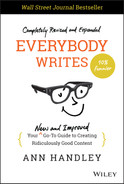14
Fifteen Ways to Organize
Good writing is like math.
It has logic and structure.
It feels solid to the reader. The writer is in control, leading the reader on a well-lit path that's clear and accessible and free of gnarled words and knobbly things readers will stumble over.
Good writing does not follow a formula, exactly. But there is an architecture to it.
* * *
There's no single way to structure a piece of writing.
I start with a single line at the top of the page that sums up the main point I'm trying to make.
Then I list some key points that relate to or support my bigger idea.
Then I go back and expand on those ideas in another sentence or two, creating paragraphs.
Then I move the paragraphs around, adding transitions between them to create a smooth flow.
In other words, I make a list.
It feels less intimidating to make a list than it does to write.
Do you ever feel stumped about where to begin a shopping list? A to-do list? A wish list for Santa?
Me neither.
Your approach might be different. Instead of a list, you might use mind mapping, a flowchart, note cards, sticky notes, a pen and paper, a whiteboard and some fat markers.
J. K. Rowling sussed out the first Harry Potter novel using graphing paper and a ballpoint pen. Marketer Andy Crestodina writes an outline and then makes the main points its headers. Then he fleshes out the outline in a kind of fill-in-the-blank exercise.
Sometimes great writing isn't written; it's assembled.
Your preferred method for organizing a piece doesn't matter. The point is to keep yourself focused and organized via a set framework so you don't meander all over the place. It also creates momentum, because you can anticipate what's next.
Sometimes the organization of a piece is suggested by its format.
Here are 15 approaches to framing your writing, using online privacy as a sample topic:
